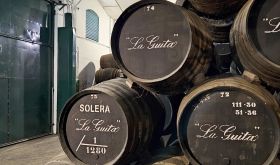From €19.95, £17.05, $27.97, 28.90 Swiss francs, 259.90 kroner, 199 Danish kroner, NZ$59.99
La Rioja Alta is one of the grand old bodegas of Rioja, based, as the name suggests, in the Rioja Alta subregion. If styles of fine rioja can today be split into classical and modern (and ‘new wave’, but that’s another story), then the La Rioja Alta brand sits squarely in the classical category.
Founded in 1890, it is located in the Barrio de la Estación area of Rioja Alta’s capital, Haro. There it clusters alongside other Rioja luminaries such as ultra-classical López de Heredia immediately opposite, Muga right next door – blending classical and modern styles – and modernistas Roda a minute or two up the road.
La Rioja Alta have a range of wines, with a pair of Gran Reservas at the pinnacle: 890, reflecting the founding date, and 904, created in 1904. Beneath those are a suite of wines, Viña Alberdi, Viña Arana and Viña Ardanza, which have been released as Reservas at progressively higher prices (although for the 2012 vintage an Arana Gran Reserva was released for the first time).
This range is produced from 415 ha (1,025 acres) that La Rioja Alta controls for that label. Separately, in 1995 the company acquired the 44-ha Torre de Oña estate in Rioja Alavesa, which remains separately branded, and which is made in the modern style. For me, that means reductively made, with plush, black fruit, sometimes notable extraction of tannins, and the tell-tale clove and chocolate aromas of French oak.
The classical style, however, is more oxidative, combining balsamic-vinegar notes with red fruit and vanilla from American oak barrels, alongside an elegant tannic structure. Viña Ardanza epitomises this perfectly, being a blend of 80% Tempranillo and 20% Garnacha, matured for 36 months in American oak barrels averaging four years of age.
The eagle-eyed will have spotted that this maturation regime would actually qualify Viña Ardanza as a Gran Reserva, but it has always been released as a Reserva.
Well, almost always.
With the release of the 2010 vintage, what is particularly interesting is that the words Selección Especial have been added to its label. This makes it the fourth vintage in the wine’s 78-year history, after the great vintages of 1964, 1973 and 2001, to be given this elevated status (the first three were simply called Reserva Especial, but it’s the same thing).
I’m not surprised that the 2010 has reached this level. Since tasting Contino Reserva 2010 a couple of years ago, followed by a broad array of riojas from different producers – both classical and modern – I’ve believed that there’s something special about the 2010 vintage. Indeed, I think that the consistency of quality of 2010s is high enough that you’d be unlucky to pick a bad example.
What makes Viña Ardanza 2010 stand out, however – and the reason I’ve selected it as my wine of the week – is that it is not only a very fine example of a classical rioja, but also a very good-value and widely available one. Total production is around 500,000 bottles a year. Wine-Searcher shows UK pricing starting just over £17 (though expect to pay delivery on top).
This is excellent value if you can snag it, but even in the more typical £20 to £25 price range, it is still a great buy. Local currency equivalents are similarly attractively priced across Europe, the US and more broadly around the world.
Back in 2011, when Jancis highlighted both the 2000 Reserva and 2001 Reserva Especial as her wine(s) of the week, Majestic were offering the 2001 at £17.59. She wrote, ‘For a wine of this quality and age, this wine is certainly not overpriced’. I bought plenty back then; I have not been disappointed.
Jancis also noted that the 2001 ‘will still be delicious in 10 years' time’. I can confirm that. A few months ago, at a ‘bring your own Spanish wine’ dinner, I took a 2001 Reserva Especial, while others coincidentally brought the 2009 Reserva and 2001 Gran Reserva 890. With weight, complexity and grace, the 2001 Reserva Especial was the wine of the night (though I think the 890 is in a closed phase and will ultimately outshine its little sibling).
Drinking the 2010, I can see a similar longevity. It has a fair tannic structure which will continue to soften to silk. It has an extra dimension of flavour density that doesn’t compromise freshness – which I think of as a hallmark of 2010s. It also opened over time, with aromas of incense and fresh earth unfurling as the bottle stood open.
Although the 2001 might ultimately edge a head-to-head between the two, the 2010 is certainly worthy of Especial status, and I heartily recommend it.















